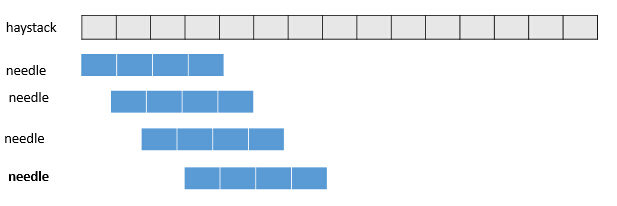Implement strStr() : https://leetcode.com/problems/implement-strstr/
Returns the index of the first occurrence of needle in haystack, or -1 if needle is not part of haystack.
如:haystack = “bcbcda”; needle = “bcd” 则 return 2
解析:字符串查找函数,strstr()函数用来检索子串在字符串中首次出现的位置,其原型为:
char *strstr( char *str, char * substr );
思路一:容易实现,然并卵(时间复杂度不满足要求)
两个指针,i 指向haystack 的起始,j 指向 needle 的起始;首先 i 向后走,直至haystack[i] == needle [j]; 然后 j 往后走,如果haystack[i+j] != needle [j] 跳出,如果能走 m 步,即存在相同,返回i;如果存在不匹配,则haystack 后移后,从needle[0]重新比较
原理就是:拿着 needle 字符串 去 haystack 上逐个比较;每次最多需要对比m次,最多重复n次;
故时间复杂度为O(m*n),不能满足leetcode的时间要求
注:在写代码前理清思路,
1. 确定解决问题的算法
2. 确定算法的时空复杂度,考虑能不能优化或询问面试官是否要求时空复杂度。
3. 有哪些特殊情况需要处理
必须必须必须先清晰思路,再写代码。
int strStr2(string haystack, string needle) {// 时间复杂度O(m*n),不能满足leetcode的时间要求int m = needle.size();int n = haystack.size();if (m == 0) return 0;if (m > n) return -1;for (int i = 0; i < n; i++) {int j = 0;if (haystack[i] == needle[j]) {for (; j < m && i+j < n; j++) {if (needle[j] != haystack[i+j])break;}if (j == m)return i;}}return -1;}思路二 Rabin–Karp algorithm算法 - Hash 查找
Rabin–Karp algorithm算法:是计算机科学中通过 hash 的方法用于在一个大量文本中查找一个固定长度的字符串的算法。(模式查找)
从思路一我们可知,要想确定haystack中存在needle,必须完全比较needle的所有字符。那么有没有能够利用上一次比较的结果,仅添加O(1)的时间。
基本思想是:用一个hash code 表示一个字符串,为了保证 hash 的唯一性,我们用比字符集大的素数为底,以这个素数的幂为基。
例如:小写字母集,选择素数29为底,如字符串”abcd”的hash code为
那么下一步计算字符串”bcde”的 hash code 为
<注>例子中是正序计算的hash code,以下程序中使用是倒序计算的 hash code, 即
hash("abcd")=4?290+3?291+2?292+1?293 ,类似于进制转换
hash("bcde")=(hash("abcd")?1?293)?29+5
int charToInt(char c) {return (int)(c-'a'+1);}// 时间复杂度 O(m+(n-m)) = O(n)int strStr(string haystack, string needle) {int m = needle.size();int n = haystack.size();if (m == 0) return 0;if (m > n) return -1;const int base = 29;long long max_base = 1;long long needle_code = 0;long long haystack_code = 0;for (int j = m - 1; j >= 0; j--) {needle_code += charToInt(needle[j])*max_base;haystack_code += charToInt(haystack[j])*max_base;max_base *= base;}max_base /= base; // 子串的最大基if (haystack_code == needle_code)return 0;for (int i = m; i < n; i++) {haystack_code = (haystack_code - charToInt(haystack[i-m]) * max_base) * base + charToInt(haystack[i]);if (haystack_code == needle_code)return i - m + 1;}return -1;}存在的缺点是,素数的幂可能会很大,因此计算结果要使用 long long 的类型 ,甚至要求更大的big int;另外,可以通过取余的方式缩小,但是有小概率误判。
算法参考:http://blog.csdn.net/linhuanmars/article/details/20276833
更多思路
KMP字符串搜索算法:
http://www.ruanyifeng.com/blog/2013/05/Knuth%E2%80%93Morris%E2%80%93Pratt_algorithm.html
https://en.wikipedia.org/wiki/Knuth%E2%80%93Morris%E2%80%93Pratt_algorithm
Boyer-Moore字符串搜索算法
http://www.ruanyifeng.com/blog/2013/05/boyer-moore_string_search_algorithm.html
https://zh.wikipedia.org/wiki/Boyer-Moore%E5%AD%97%E7%AC%A6%E4%B8%B2%E6%90%9C%E7%B4%A2%E7%AE%97%E6%B3%95
